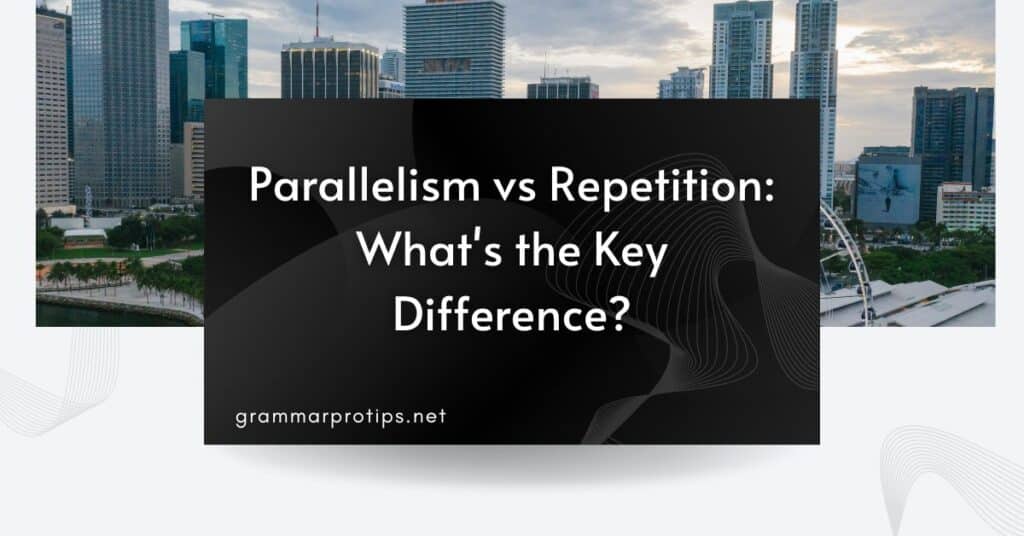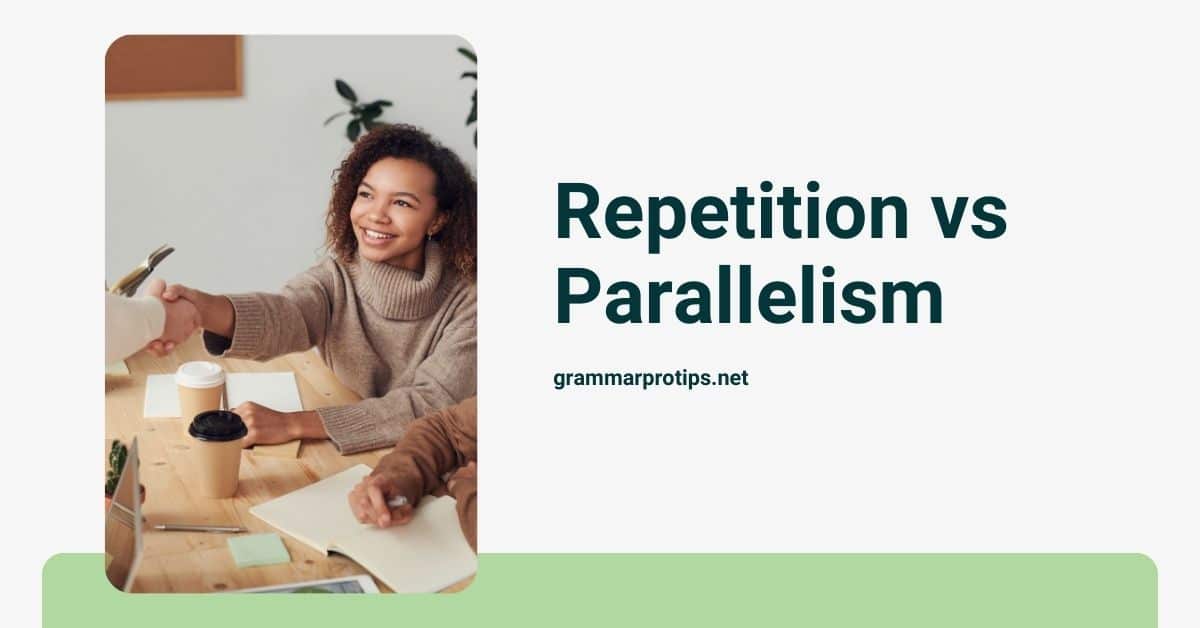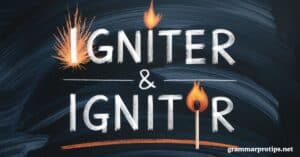In the world of writing, certain techniques can transform ordinary sentences into compelling and engaging pieces of work. Among these techniques, repetition vs parallelism stand out for their unique ways of emphasizing ideas.
Both are stylistic tools, but they serve different purposes and are applied in varying contexts. Understanding the difference between parallelism and repetition is essential for effective communication.
Let’s dive into these two concepts, explore their parallelism vs repetition examples, and highlight how they function in different scenarios. We’ll break it down into digestible parts, with plenty of examples, scenarios, and a helpful table to guide you through the differences.
What is Repetition?
Repetition is a rhetorical device where a word, phrase, or idea is intentionally repeated to emphasize a particular point or create a rhythm in writing. The idea is to reinforce a message and make sure it sticks in the reader’s mind.
In a business email, for example, repetition can be used to stress urgency or clarity. Here’s a simple example:
Email Example:
Dear Mark,
I wanted to follow up on our project deadline. The project deadline is fast approaching, and we must ensure all tasks are completed before the deadline. Please confirm your availability so we can meet the project deadline.Best regards,
Sarah
In this email, “deadline” is repeated three times to emphasize its importance. The repetition draws attention to the crucial deadline and underscores its urgency.
Types of Repetition
Repetition comes in several forms, including:
- Anaphora: The repeated beginning of a phrase or sentence. This is when a writer starts several sentences or clauses with the same word or words.
- Epiphora: The repetition of words at the end of clauses or sentences.
- Diacope: Repetition of a word or phrase with only one or a few intervening words.
Example of Anaphora:
“We will not rest. We will not quit. We will not falter.”
Here, “We will not” begins each phrase, emphasizing determination.
What is Parallelism?
On the other hand, parallelism (also known as parallel structure or parallel syntax) refers to using the same grammatical structure in multiple parts of a sentence or throughout a series of sentences. This creates balance and flow, making the writing more harmonious and easier to read.
Parallelism in Literature
Parallelism is especially prominent in literature because it helps authors create rhythm, clarify meaning, and make their writing memorable. It’s often used in speeches, poetry, and novels to evoke emotion and drive home key themes.
Parallelism Example:
“She was walking, running, and jumping all at once.”
Here, the verbs “walking,” “running,” and “jumping” follow the same grammatical structure, making the sentence feel cohesive and balanced.
Parallelism in Speech
Think of famous speeches where parallelism shines. Martin Luther King Jr.’s “I Have a Dream” speech is an excellent example. The repeated use of “I have a dream” creates a rhythm that reinforces his vision for the future.
Example from the speech:
“I have a dream that one day this nation will rise up and live out the true meaning of its creed. I have a dream that one day on the red hills of Georgia, the sons of former slaves and the sons of former slave owners will be able to sit down together at the table of brotherhood.”
In this case, the parallelism adds emotional power to King’s words, driving his message deep into the hearts of his audience.
Parallelism vs Repetition: What’s the Key Difference?

At first glance, parallelism vs repetition might seem similar, but there are key differences between the two. Repetition involves repeating words or phrases to reinforce an idea or emotion. Parallelism, however, focuses on creating balance in a sentence or series of sentences by aligning similar structures.
Let’s explore a detailed comparison of the two:
| Repetition | Parallelism |
|---|---|
| Repeats a word, phrase, or idea. | Uses similar grammatical structures in a series. |
| Emphasizes or intensifies a point. | Creates harmony and flow in the sentence. |
| Can be overused to sound redundant. | Adds elegance and balance to writing. |
| Often used for emotional emphasis. | Often used for clarity and coherence. |
Practical Examples of Repetition vs Parallelism
Let’s see how repetition and parallelism differ in real-world scenarios. Here are a few examples, including parallelism vs repetition examples from emails and literature.
Email Example: Repetition
Subject: Urgent Reminder: Team Meeting
Dear John,
I wanted to remind you about the team meeting tomorrow. The team meeting is scheduled for 9:00 AM, and it’s essential for everyone to attend. Please make sure you arrive on time for the team meeting.
Looking forward to seeing you there.
Regards,
Emily
In this example, the word “team meeting” is repeated to emphasize its importance and ensure that the recipient understands the significance of the event.
Email Example: Parallelism
Subject: Steps to Complete the Report
Dear Team,
To complete the report successfully, you need to gather data, analyze the findings, and present them clearly. Please remember, accuracy, clarity, and precision are key to delivering a quality report.
Best,
Karen
Here, parallelism is evident in the balanced structure of the verbs in the first sentence (“gather, analyze, present”) and the adjectives in the second sentence (“accuracy, clarity, precision”). The use of parallel structure makes the email clear and easy to follow.
Parallelism vs Repetition in Literature
Literature often uses both techniques to enhance storytelling, evoke emotions, or emphasize certain ideas.
Parallelism Example in Literature:
Take a look at this passage from Charles Dickens’ A Tale of Two Cities:
“It was the best of times, it was the worst of times, it was the age of wisdom, it was the age of foolishness, it was the epoch of belief, it was the epoch of incredulity…”
This passage uses parallelism to show contrasting ideas in a balanced, rhythmic structure. The repetition of “it was” helps reinforce the dualities of the era.
Repetition Example in Literature:
In Edgar Allan Poe’s poem “The Raven,” repetition is used to create an eerie atmosphere and emphasize the speaker’s desperation:
“Nevermore,” said the Raven.
“Nevermore,” said the Raven.
“Nevermore,” said the Raven.
Here, “Nevermore” is repeated, creating a sense of finality and despair.
Polysyndeton and Parallelism
Polysyndeton is another technique that involves the repetition of conjunctions (like “and,” “or,” “but”) in close succession. While it can often be used alongside parallelism, polysyndeton stands out for its repetition of conjunctions rather than words or phrases.
Example of Polysyndeton:
“I bought bread and cheese and milk and butter.”
This creates a feeling of abundance, or even exhaustion, by emphasizing each item through repeated “and”.
Applying Parallelism in Professional Writing
In professional or business writing, parallelism enhances clarity and professionalism. It’s particularly useful in emails, reports, presentations, and proposals, where clarity is key. Here’s an example of how to apply parallelism effectively in a business context.
Example:
“To succeed in the project, we need to gather information, analyze the data, and develop a strategy.”
Notice how the verbs—“gather,” “analyze,” and “develop” are all presented in a consistent parallel structure, making the sentence more effective and easy to read.
Parallelism Examples

Here are a few examples of parallelism in various contexts:
1. Simple Sentence Structure:
“She enjoys reading, writing, and painting.”
In this sentence, the three verbs enjoys reading, writing, and painting are structured in the same way, creating a smooth and balanced flow.
2. Literary Parallelism:
“The sun was setting, the stars were twinkling, and the moon was rising.”
This example from literature uses parallel structure to describe the natural scene with balance, making it easier to read and more poetic.
3. Speeches and Rhetoric:
“We cannot dedicate, we cannot consecrate, we cannot hallow this ground.” — Abraham Lincoln, The Gettysburg Address
Here, the repeated “we cannot” followed by parallel verbs creates a rhythm and emphasizes the impossibility of fully honoring the sacrifices made.
4. Business Writing:
“Our goals are to innovate, to collaborate, and to grow together.”
In this professional sentence, the infinitive phrases to innovate, to collaborate, and to grow—create a clear and balanced message that is easy to follow.
5. Everyday Conversation:
“He likes to play basketball, to watch movies, and to read books.”
This example uses parallel structure by keeping the infinitive phrases consistent, which makes the sentence feel harmonious and natural.
6. Parallelism in Lists:
“The meeting will cover project updates, budget reviews, and team assignments.”
The parallel structure in this list ensures that each item is presented in a similar grammatical form, making it easier for the reader to absorb.
7. Contrasting Ideas:
“She was the most compassionate, the most understanding, and the most patient person I knew.”
In this example, “the most” is repeated for emphasis, creating a balanced and rhythmic sentence that draws attention to the subject’s qualities.
8. Balanced Ideas in Complex Sentences:
“While she studied hard for the exam, she also participated actively in class discussions and volunteered for extra assignments.”
Here, the structure “she studied,” “she participated,” and “she volunteered” maintains consistency, allowing the sentence to flow smoothly.
Conclusion: Understanding the Difference
Understanding the difference between repetition and parallelism helps you use these techniques purposefully. Repetition can create emphasis, rhythm, and emotional impact, while parallelism provides balance, coherence, and a smooth reading experience. Both have their places in different forms of writing, from emails to speeches to literature.
As you practice, remember to consider the tone and purpose of your message. Use repetition when you want to drive a point home or evoke strong emotions, and lean on parallelism when you aim for clarity and a rhythmic flow.
Whether you’re drafting an email, writing a poem, or delivering a speech, mastering these techniques will take your writing to the next level. So, next time you’re editing your work, ask yourself: Are you using repetition or parallelism to best express your message?

Sienna Mauldon is a passionate writer and grammar expert. On her blog, she shares easy-to-follow guides to help readers master grammar rules and improve their writing. With a love for language and teaching, Sienna makes grammar simple and fun for everyone, from beginners to experienced writers.








